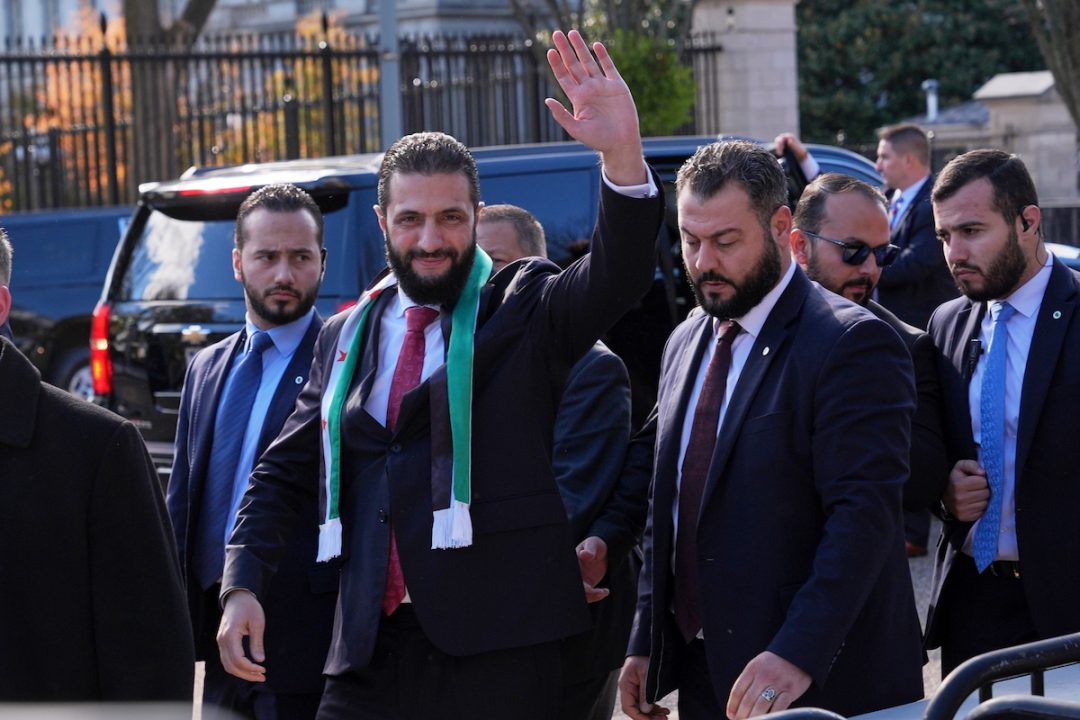
On Monday, president Donald Trump met with Syrian President Ahmed al-Sharaa at the White House, marking the first visit by a Syrian head of state since the fall of the Assad government. Al-Sharaa, a former al-Qaeda commander who seized power in Damascus with his faction Hay’at Tahrir al-Sham (HTS) last December, arrived as Washington’s newest partner in regional security.
Official photographs showed Interior Minister Anas Hasan Khattab, another former al-Qaeda member, alongside Secretary of State Marco Rubio, Vice President J.D. Vance, and U.S. Ambassador to Turkey Tom Barrack, who has served as Trump’s envoy to Syria.
Speaking afterward, Trump called al-Sharaa “a very strong leader.” He added, “We’ll do everything we can to make Syria successful.” The discussions centered on two interconnected tracks — security collaboration and economic normalization — signaling Washington’s intent to reposition Syria not as a pariah but as a conditional partner in a reorganized Middle East.
Security Collaboration
Syria’s first major step under the new arrangement was joining The Global Coalition to Defeat ISIS.
According to Turkey’s Anadolu Agency, Information Minister Hamza al-Mustafa described the deal as “political” and “without military components,” framing Syria as “a partner in combating terrorism and supporting regional stability.”
The symbolism was clear. Al-Sharaa once led HTS, a group born from al-Qaeda’s Syrian branch and long at odds with both ISIS and the Bashar al-Assad regime. His inclusion in a Western-backed coalition reframed that history, recasting a onetime insurgent as a participant in the global fight against extremism.
Reuters reported on November 6 that the United States is “preparing to establish a military presence at an airbase in Damascus” as part of a broader pact linking Syria and Israel. Washington already maintains troops in northeastern Syria to support Kurdish-led forces against ISIS remnants. Anadolu quoted al-Mustafa as saying that Trump “expressed his support for a potential security arrangement with Israel, aimed at enhancing national and regional stability.”
In practice, the deal opens channels for intelligence sharing, border coordination, and counterterror operations. For Washington, it restores influence over Syria’s security policy without committing major troop deployments. For Damascus, it delivers the international legitimacy that had long been out of reach.
Sanctions Relief
The economic side of Trump’s Syria strategy marks the most sweeping rollback of U.S. sanctions since the civil war began in 2011. The Treasury’s Sanctions and Export Controls Relief for Syria brief, released Monday, states that the administration is “committed to supporting a stable, unified, and peaceful Syria.”
With a U.S.-aligned regime now in place, Washington appears to see little purpose in continuing economic strangulation. The Treasury argued,
Removing U.S. sanctions will support Syria’s efforts to rebuild its economy, provide prosperity for all its citizens, including its ethnic and religious minorities, and combat terrorism.
The shift began May 13, when Trump announced the lifting of sanctions. A June Executive Order 14312 formally ended the Syria Sanctions Program under 31 C.F.R. Part 542 and directed agencies to promote U.S. and foreign investment.
The Treasury also suspended enforcement of the Caesar Syria Civilian Protection Act of 2019 for another 180 days, keeping only restrictions tied to Russia and Iran. The Act had imposed sweeping secondary sanctions on anyone providing financial or material support to Assad’s regime or its allies. With most of those provisions halted, basic civilian-use goods, software, and technology can now be transferred to Syria without a license.
Restrictions remain on what officials called “the worst of the worst” — former president Bashar al-Assad and his associates, human rights violators, and narcotics traffickers. But for the first time in more than a decade, Damascus can access limited trade and financial channels.
Exports and Designations
The administration paired sanctions relief with a loosening of export controls. A new Commerce Department rule now allows most civilian-use and infrastructure-related exports to proceed without a license. That covers telecommunications, sanitation, power generation, and civil aviation. Regulators were instructed to give “favorable” consideration to exports that support essential services and reconstruction.
The delisting of Syrian figures followed the same rationale. In July, the U.S. revoked the Foreign Terrorist Organization designation of HTS. On November 7, it removed Ahmed al-Sharaa and Interior Minister Anas Hasan Khattab from the Specially Designated Global Terrorist (SDGT) list. Khattab, a former HTS political officer in Idlib, now serves as Syria’s top security official.
The delistings concluded a process that had begun months earlier, turning figures once labeled extremists into recognized heads of government. For Washington, it was a pragmatic bet — that rehabilitation would prove more useful than punishment in shaping Syria’s trajectory.
The State Department still lists Syria as a State Sponsor of Terrorism, yet the designation may soon be reviewed. Trump has framed the broader shift as “giving Syria a chance at greatness,” a phrase now functioning as both slogan and justification.
“Rough Past”
The most notable aspect of the meeting was not policy but history. Ahmed al-Sharaa, once listed by the United States as a terrorist with a $10 million bounty, arrived at the White House as a head of state. On Veterans Day, the president who had pledged to “eradicate radical Islam” met the man who had led one of its most infamous factions.
For more than a decade, al-Sharaa — known to intelligence agencies as Muhammad al-Jawlani — commanded Jabhat al-Nusra, al-Qaeda’s Syrian branch. As reported by The New American back in 2015, the faction’s fighters were aided inadvertently by the Obama administration. The forces imposed Islamist rule across Idlib, ran detention centers, and financed their operations through ransom and oil smuggling. When the group rebranded as Hay’at Tahrir al-Sham in 2017, it claimed independence from al-Qaeda but retained its leadership and ideology.
His rehabilitation was political, not moral. By 2024, U.S. and Israeli officials had settled on a pragmatic calculation: Islamist factions hostile to both Assad and Iran were preferable to a secular dictatorship aligned with Tehran. That winter, Israel intensified airstrikes on Syrian and Iranian targets but quietly tolerated HTS control in the northwest as a buffer. Washington adopted the same logic, viewing HTS as a counterweight to both ISIS remnants and Iranian proxies.
Not surprisingly, when Assad’s regime finally collapsed, the United States and its partners accepted al-Sharaa as a legitimate leader.
At the Oval Office, Trump dismissed concerns about al-Sharaa’s past: “People say he had a rough past. We’ve all had rough pasts.” The remark collapsed years of war and ideology into a shrug, exposing the familiar logic of Washington’s adaptable foreign policy — one that arms, absolves, and repurposes the very forces it once vowed to destroy whenever they prove useful to its goals.





